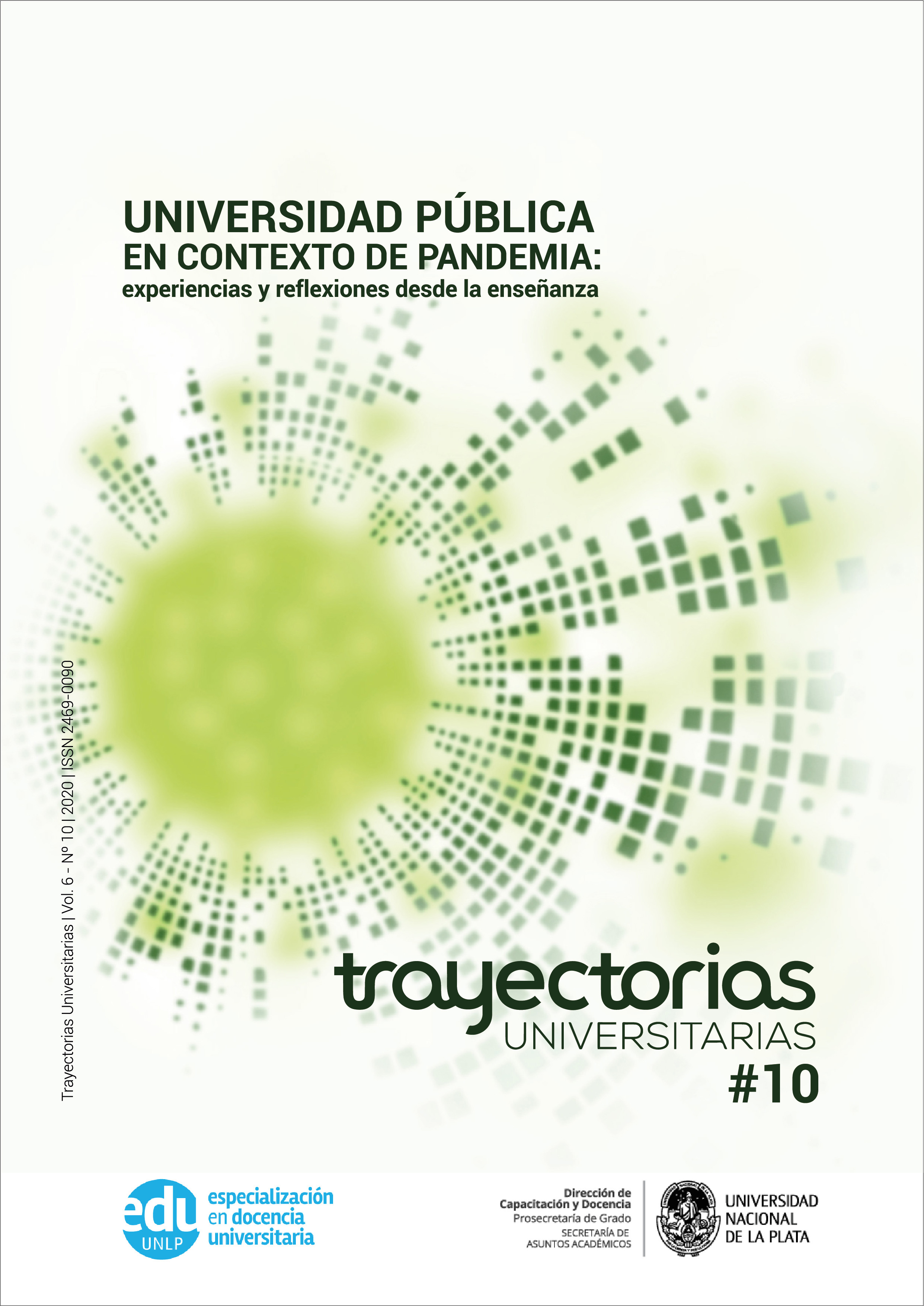Does all solid fade in quarantine?
DOI:
https://doi.org/10.24215/24690090e026Keywords:
time, teacher training, pandemic, daily lifeAbstract
The certainties, or at least some from where we started to think about the classroom space, are in “recalculating” mode. Uncertainty invades us, confuses us and at the same time invites us to rethink our practices, to produce knowledge from other formats but always from a shared conviction: teamwork, in which each of us contributes from a perspective, a trajectory in the chair that is complemented by dialogue and trust, sharing doubts and hopes. A whole exercise in creativity within the team and with and for the students.
The categories of time and space imploded, taking other dimensions in the educational field. Corporeality also entered and enters other dimensions, such as teachers, the working hours became more extensive, more demanded. Everyday life was completely altered, working times become fuzzy.
The bodies, divided into windows of a screen, were and are the possible support for generating encounters and constructing senses.
In this work we want to share the debates within the teaching team and with our students about the very possibility of practicing in secondary schools and the path that we can take from the screen until classes are “normalized” in the College.
The sources used are the school biographies of the students and the records of three virtual activities via jitsi in which we “meet” with them and with teachers at the secondary level who work in different schools in the City of La Plata. and Gran La Plata.
These virtual meetings promoted questions and debates that made it possible to think the context from voices that enunciate diverse experiences.
Producing pedagogical documentation of this very particular time is one of the objectives that guides us, an objective that is not alien to reflection on practice in a diachronic view with the own experiences and those of the students.
The concept that allows us to articulate the categories of time, space and subjects is that of school culture, defined by Dominique Julia (2001), which refers both to norms and to coordinated practices for purposes that vary according to the times in a chrono-system that enables talking about school culture (s) in plural.
It is also evident that this work is produced in the heat of an unprecedented situation and in that sense our reflections are translated aloud.
KEY WORDS: time, teacher training, pandemic, daily life
Downloads
Metrics
References
DAVINI, M. C. (1995). “La formación docente en cuestión: política y pedagogía”. Buenos Aires: Paidós.
DIKER, G. y TERIGI, F. (2008). “La formación de maestros y profesores: hoja de ruta”. (1º ed. 3ª reimp). Buenos Aires: Paidós.
JULIA, Dominique (2001). “A cultura escolar como objetivo histórico”. Revista Brasilera de História da Educação n° 1, 9., 2001, 43.
PINEAU, P. ( 22/04/2020). “¿Y si la escuela para de golpe? Comentarios sobre la actual situación educativa”. Compartido en el muro de Facebook de la Asociación Argentina de Historia de la Educación. Disponible en: https://www.facebook.com/sahe95/posts/2937021459674526?__tn__=K-R
TRIGO, L. (2007). “El lugar de la Didáctica Específica de la geografía en la formación docente”. En: Gema Fioriti y Patricia Moglia (comp.) La formación docente y la investigación en Didácticas Específicas. Cuadernos del CEDE: Universidad Nacional de San Martín.
SAINT-EXUPÈRY, Antoine (2003). “El Principito”. Biblioteca Virtual de la UEB http://www.ueb.edu.ec
Downloads
Published
How to Cite
Issue
Section
License
La aceptación de un original por parte de la revista implica la cesión no exclusiva de los derechos patrimoniales de los/as autores/as en favor del editor, quien permite la reutilización, luego de su edición (postprint), bajo una Licencia Creative Commons Atribución-NoComercial-CompartirIgual 4.0 Internacional (CC BY-NC-SA 4.0).
Acorde a estos términos, el material se puede compartir (copiar y redistribuir en cualquier medio o formato) y adaptar (remezclar, transformar y crear a partir del material otra obra), siempre que a) se cite la autoría y la fuente original de su publicación (revista y URL de la obra), b) no se use para fines comerciales y c) se mantengan los mismos términos de la licencia.
La cesión de derechos no exclusivos implica que luego de su edición (postprint) en Trayectorias Universitarias los/as autores/as pueden publicar su trabajo en cualquier idioma, medio y formato; en tales casos, se solicita que se consigne que el material fue publicado originalmente en esta revista.
Tal cesión supone, también, la autorización de los/as autores/as para que el trabajo sea cosechado por SEDICI, el repositorio institucional de la Universidad Nacional de La Plata, y sea difundido en las bases de datos que el equipo editorial considere adecuadas para incrementar la visibilidad de la publicación y de sus autores/as.
Asimismo, la revista incentiva a los/as autores/as para que luego de su publicación en Trayectorias Universitarias depositen sus producciones en otros repositorios institucionales y temáticos, bajo el principio de que ofrecer a la sociedad la producción científica y académica sin restricciones contribuye a un mayor intercambio del conocimiento global.





















